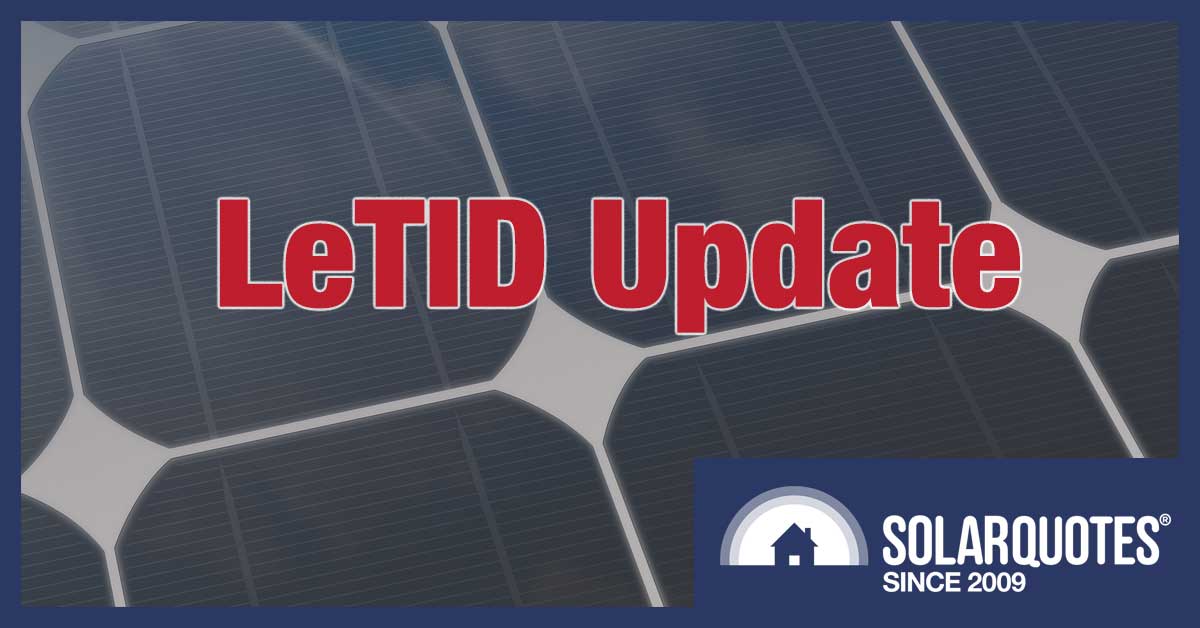
LeTID: Limited in new PERC panels from reputable manufacturers and probably not a disaster for old ones.
Fourteen months ago I wrote about a type of solar panel degradation called LeTID. This is short for Light and elevated Temperature Induced Deterioration. It’s also Norwegian for “laugh time” which is what I think they called the Joker movie over there.
LeTID loss is experienced by PERC panels, which are now the most commonly produced kind on the planet. A lot of installed panels have the potential to suffer from it.
While first discovered back in 2012, LeTID mostly took the solar industry by surprise and only became a well-known issue around two years ago. Manufacturers weren’t happy to discover PERC technology introduced to increase efficiency at low cost could end up costing CEOs their Lamborghinis — or Hyundais in the case of leaner operators.1
The LeTID problem was first really brought to Australian attention by Ben Neville of MC Electrical in this article. Five months later I wrote about it here and concluded that — while it was a serious problem — we probably didn’t need to panic because major solar panel manufacturers were working hard to fix the problem. But I’m concerned corporate PR departments would say that even if it was a surging tsunami of disaster. So I’m revisiting the issue to see if — 14 months after my original article — I was right that there was no real need to panic. Or if I should upgrade my recommendation to full-blown hysterical panicking.
In this article I will tell you:
- What LeTID is and how it differs from its degrading brother LID.
- The kind of panels that suffer it and why LG Neon and SunPower Maxeon panels don’t.
- How bad LeTID is and why it’s probably not a disaster if panels on your roof suffer from it.
- How to minimise your chances of getting solar panels that suffer LeTID or avoid it entirely.
By the time you’ve finished reading you should be able to decide for yourself whether PERC solar panels are the best thing since sliced bread or the worst thing since bread that gets sliced after you’ve eaten it.
LeTID Is Not LID
One form of PV degradation known about for decades is Light-Induced Degradation or LID. This affects most panels, including all PERC ones, and causes around a 2% decline in output in the first couple of days of exposure to sunlight. It’s quite different from LeTID that takes years to reach its full extent and can result in much greater deterioration. A quick summary of the differences are:
- LID: Around 2% deterioration. Takes days to occur. Worse in monosilicon solar panels.
- LeTID: Can cause over 10% deterioration in severe cases. Takes years to reach full extent. Worse in polysilicon panels.
All panels that suffer from LID account for it in their performance warranties which generally allow a 2.5% deterioration in the first year. Because LeTID more or less took the PV industry by surprise, warranties contain no special provisions for it.
Percentage Deterioration — Not Percentage Points
Just to be clear, if I say a solar panel degrades by 2% I mean it will produce 2% less energy. It doesn’t mean a 2 percentage point decrease in panel efficiency. A 20% efficient panel that degrades 2% will become a 19.6% efficient panel, not an 18% efficient one.
What Is LeTID?
No one knows what LeTID is caused by. Not when you get down to the nitty-gritty level of atoms and molecules.2 But researchers working it are pretty sure hydrogen is involved. This is a pity because other researchers are trying to put more hydrogen in solar cells to fix other problems.
While we don’t know all the chemical details of what’s going on inside solar cells, we don’t have to understand what’s going on to describe LeTID, as I am about to do. Here it goes… I’m getting ready to describe it… Any keystroke now… Here it comes…
Light and elevated Temperature Induced Deterioration is deterioration induced by light and elevated temperature.
Gee… that turned out to be easier than I thought it would be.
If you want some details, if you want me to go into the nitty-gritty specifics of just what kind of light and what kind of temperatures are required, I can do that.
The type of light that is bright enough to cause LeTID is sunlight. While you could install panels in the shade, indoors, or upside down to prevent them from being exposed to sunlight, I can’t recommend this. You’ll lose far more output than you ever will from LeTID and exposure to sunlight is sort of the whole point of solar panels. Sure, they still work when it’s cloudy, but they work a lot better when them blue skies are smiling down.
Sunlight alone isn’t enough to cause LeTID. Elevated temperatures are also required. It can occur anywhere solar panel temperatures regularly exceed 50 degrees in the summer. This map shows all the locations in Australia where this occurs:
It doesn’t matter if the panels are in Hobart or the Snowy Mountains, in this country they will get hot enough to suffer from LeTID. In Hobart, it won’t occur as fast as in Marble Bar, but it will happen. In Australia, if your solar panels are susceptible, there is no escape.
LeTID Is A PERC Panel Problem
Maybe — technically — every single solar panel in the world suffers from some tiny amount of LeTID. But it’s mostly insignificant in panels that aren’t PERC and so wasn’t an issue until PERC panels became popular.
If you want to know what a PERC panel is you can read about them here — but I can’t recommend doing that because a commenter thought reading that article was about as pleasant as watching President Lyndon Johnson pass a kidney stone. To save you any unnecessary anguish, I’ll explain right here right now what PERC panels are. In a nutshell, they have cells with back-surface that increases efficiency over the traditionally used aluminium backing. Because of its relatively low cost, the majority of solar panels produced are now PERC.
Unfortunately, it appears the PERC process creates “reservoirs”3 of hydrogen that can work evil LeTID magic on panels. I can’t explain the process in more detail than that because there’s a big difference between reading scientific papers and actually understanding them.
LeTID Affects Monosilicon Less
Polysilicon PERC panels suffer from considerably more LeTID than monosilicon ones. Monosilicon solar cells are made from a single crystal of silicon and look uniform while polysilicon has a “crazy” appearance caused by multiple crystals that makes them look kind of pretty. They are also usually bluer than monosilicon:
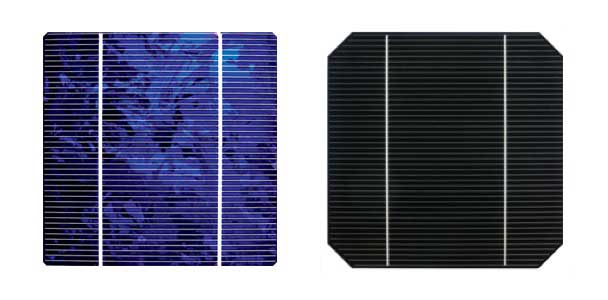
Monosilicon on the right and pretty Polysilicon left.
Monosilicon is a little more efficient, while polysilicon is a little cheaper. Fortunately for Australian households, the number of polysilicon panels installed on roofs has dived over the past couple of years, reducing the chances of rooftop solar suffering from severe LeTID.
Interestingly, silicon from different manufacturers can develop very different levels of LeTID in the field. But even though they may not fully understand what causes it, PERC solar panel manufacturers can reduce it simply by using less susceptible silicon.
N Type Panels Are LeTID Resistant
If you don’t want your panels to have any LeTID, the good news is there are high-efficiency solar panels that don’t suffer any detectable amount. These are panels that use N-type cells. Most solar panels and all PERC ones use lower-cost P-type cells. LG Solar and SunPower Maxeon panels (SunPower Maxeon 2 and 3 series) are the only N-type panels I know that are commonly sold in Australia, although Panasonic produces them too. If you have these, you can be very sure they’ll be effectively LeTID free. They also have the advantage of not suffering from LID.
If you want to find out the details of N-type and P-type cells you can read this article I wrote. You don’t need to worry about the quality of my writing this time, as it has Keanu Reeves in it, which makes everything better.
How Bad Is LeTID?
LeTID is bad, but it’s not a death sentence for solar panels that have it. In a hot environment — like most of Australia — it will gradually progress over several years, causing more decline in output each year, but then it will taper off and stop getting worse. Estimates for how bad it will get vary wildly from source to source and range from…
- up to 16%
- up to 10%
- over 7%
My guess is if we ignore extreme results, then if your solar panels suffer from major LeTID degradation, it is still likely to be less than 10% for polysilicon panels and less than 7% for monosilicon. But keep in mind you could still be unlucky and lose over 15% deterioration.
If you bought your PERC solar panels three years ago, then in a hot environment like Queensland they may have reached their maximum LeTID deterioration by now, while in Tasmania they may continue to degrade slowly for years to come.
Solar Panels May Recover From LeTID
Panels that suffer from LeTID may recover some, or perhaps a great deal, of their lost output if given enough time. The problem is PERC solar panels haven’t been used long enough in real-life conditions for us to know for certain. But in a hot climate like Brisbane, there may be significant recovery after eight years while in a cold and snowy climate it may take 20 years — assuming they develop LeTID in a cold climate in the first place.
If you are optimistic you can look forward to LeTID affected panels recovering but, despite the PV industry being reasonably confident it can happen, I wouldn’t count on it. However, I suppose there is nothing wrong with crossing your fingers and hoping. (Unless of course that time would have been better spent screaming and running away in a blind panic.)
Is LeTID That Bad?
If you bought a solar system with monosilicon panels and they suffered 7% degradation due to LeTID, that is a bad thing. Mathematically speaking, it is infinitely worse than 0% LeTID. If you paid $7,000 for your solar system, then 7% degradation is like being ripped off by $490.4 Worse than that, the lost production is likely to cost you much more over the life of the system.
While I’d certainly be upset with losing 7% of output to LeTID, since I’d still be getting 93% of the expected output I probably wouldn’t become so enraged that I’d turn green, grow 10 feet tall, and use brute strength to rip the solar panels off the roof and smash them over my head. It’s very unlikely I’d do this, as I’m a very relaxed kind of guy. But I do admit doing this when my Abrams tank didn’t come with the upholstery I ordered…
Of course, one of the reasons I might not get too annoyed is because solar panels come with performance warranties that protect against loss of output from any source when used according to their manufacturer’s recommendations.
Solar Panel Warranties & LeTID
Fortunately, every PERC solar panel on Australian rooftops has a 25-year performance warranty (30 years in some cases). It covers deterioration from sources internal to the panel when used normally5 and covers deterioration from LeTID. Here’s a diagram showing the performance warranty the world’s largest solar panel manufacturer gives one of their panels:
This one allows for 2.5% deterioration in the first year and 0.6% each year after that.6 But if you bought older PERC panels a couple of years ago it’s likely the performance warranty won’t be quite as good and will instead be 2.5% in the first year and 0.7% for each additional year. This means the maximum amount of degradation it can suffer in its first five years and remain in warranty will be:
- Year 1: 2.5%
- Year 2: 3.2%
- Year 3: 3.9%
- Year 4: 4.6%
- Year 5: 5.3%
So during the fourth year, if your panel has suffered 2.5% from LID and other causes and 3% deterioration from LeTID, it will have suffered from a total of 5.5% deterioration. As this exceeds the maximum the warranty allows it will be possible to make a warranty claim.
Measurement Accuracy And Warranties
If you read the fine print on solar panel warranties, you will see most of them are pretty crap. While they have generally improved, it was not uncommon a couple of years ago for the small print to claim they were allowed a wide margin of error on measurements equal to an extra 3% of deterioration. Fortunately, in Australia, you are protected by Consumer Guarantees and companies are not allowed to get away with using small print to reduce the effectiveness of their warranties in this way. They can require an accurate measurement, but they can’t require a wide margin of error.
In practice, when panels are obviously degraded, reputable manufacturers will replace them without a great deal of fuss. But they can require independent testing, and if that testing shows they are within their performance warranty, then the person making the warranty claim is responsible for the cost. So if you suspect your solar panels have fallen out of their performance warranty but it’s only borderline, the best option can be to put up with it and keep an eye on them to see if they get worse.
Diagnosing Deterioration
The hard part for homeowners is knowing if their panels have suffered from LeTID. While some people — like me — might keep detailed records of solar output to help spot declining output, most people don’t do that. The most effective solution is to use solar panel monitoring as this can let you see if problems are developing, and the best ones will send you a notification if there is a problem. But these cost money which makes it a bit of a Catch-22 situation. If you instead spend the money getting a better solar power system, you may not have any problems that need monitoring. But it’s good for the solar industry if you get it because it allows problems to be seen and fixed, so if you can spare the money, please consider it.
For those without monitoring an excellent resource is the Solcast PV performance estimate page. If you enter details of your system it will give you an estimate of how much energy it should have generated over the past week based on local weather conditions. But note it is just an estimate and will only indicate if your system if underperforming now. Unless you’ve kept records, you won’t know if your system has been like that since day one, in which case panel deterioration isn’t the problem. But if you try it over a couple of weeks and it appears obvious that your system is not performing as well as it should — and you are confident that’s not because of dirt or shading — then you may wish to contact your installer and let them know there is a problem.
If your installer is no longer around then if you get another installer to inspect your system (which is something you generally should do every 5 years anyway) they can help you decide if you need to make a solar panel performance warranty claim.7
Manufacturers Have Taken Action
When I first looked into LeTID it appeared many major manufacturers were willing to say they were taking steps to limit LeTID, but I got the impression they didn’t want to say it very loud. I’m guessing they wanted to reassure technically minded people on the one hand, but not draw attention to the problem on the other hand; presumably in the hope that the people buying solar panels wouldn’t realise there was an issue at all.
I guess this strategy worked as I don’t recall hearing any anti-renewable fossil fools claiming LeTID would destroy solar panels. Instead, they just trotted out the same old arguments they’ve been using for decades. But within the PV industry, there was a lot of panic and for good reason. If enough panels failed to live up to their performance warranties manufacturers could go bankrupt. As a result, two years ago there were a lot of people in the industry shitting bricks and sweating bullets. Or in Astroboy’s case, vice versa:
Luckily for them, the worst-case scenarios didn’t come to pass. While some large solar farms no doubt had to be compensated, I haven’t heard of any major producer going bust specifically because of LeTID. But, because it takes years to fully manifest, it could still happen.
Currently, all major manufacturers appear to be on top of the problem, and any PERC panels you buy now are very likely to remain within their performance warranties. This, of course, doesn’t apply if you buy a crap panel from a crap manufacturer, so caution when buying solar panels is still required. If you want to know which ones we consider reliable and well supported in Australia, there is a graphic displaying them in our Solar 101 Guide.
LeTID Testing
Several organisations have developed tests to detect LeTID, and PV Evolution Labs is one of them. Their 2020 PV Module Reliability Scorecard subjected over 50 different modules to testing designed to simulate years of use in a hot climate. The results were reassuring:
This means the majority of solar panels tested should remain within their performance warranties. But the report does warn claims that panels are “LeTID free” may not be true. This graph gives test results for two almost identical panels from a manufacturer that described both this way:
To avoid being taken in by manufacturer dishonesty, PV Evolution Labs strongly recommends more testing by companies like PV Evolution Labs.
LeTID — Still No Need For Panic
My 14-month-old conclusion that there is no need to panic appears to have held up. LeTID is annoying — for one thing, it’s difficult for most homeowners to tell if their panels have degraded — but there are mitigating factors that make it a not-really-worth-panicking-about event:
- PERC solar panels bought today or within the past year or so are unlikely to suffer from significant LeTID
- LeTID in PERC panels installed over a year ago may be mild enough for them to remain within their performance warranties.
- If LeTID doesn’t remain mild, they can be replaced under their performance warranties and Australian Consumer Guarantees.
- In a worse case situation where it’s not possible to make a warranty claim on badly affected panels, LeTID is likely to reduce output by less than 10% which is bad – but not disastrous.
- Given enough time at least some LeTID deterioration may reverse itself.
While LeTID is a concern for people who had PERC panels installed over a year ago, I hope and expect it won’t be a serious problem for most of them. If you’ve bought solar panels since then from a reputable manufacturer, you probably don’t have anything to worry about. But if you want to improve your chances of avoiding LeTID problems you can:
- Buy LG Solar or SunPower Maxeon panels, as they suffer no significant LeTID.
- If you buy PERC solar panels, choose monosilicon over polysilicon.
- Get panels from a reliable manufacturer.
- Get ones with better than average performance warranties.
If you are buying solar now, then provided the panels are from a reputable manufacturer, I would say there is no need to take special precautions unless you’re particularly paranoid. I’m so certain the solar industry has gotten on top of the LeTID problem that, rather than represent LeTID with the disturbing clown image I used at the start of this article, I’m going to use a happy clown picture instead:
Clearly, this guy couldn’t hurt a fly.
Footnotes
- Personally, I drive a Hyundaighini. Anyone can get one of these by having a very expensive accident and then not removing the parts of the Italian sports car that get stuck in your vehicle. ↩
- Interestingly, the smaller things are, the grittier they get, right up until you get down to one Planck Length. Beyond that, the universe is composed entirely of arbitrary bullshit. ↩
- The technical name for these reservoirs is “buckets”. These reservoirs cause hydrogen to get chemically stuck and hang around long term instead of quickly diffusing away as it does in material it doesn’t feel any attraction towards. ↩
- Because it takes time to reach its full extent and there is a possibility of some recovery over time, a maximum LeTID deterioration of 7% means total energy loss will be a less than 7%. Still, I don’t want to get too picky. ↩
- This means it doesn’t cover dirt, which is an external problem. It also doesn’t cover panels not installed to the manufacturer’s recommendations. This is why it’s important to get an installer who knows and cares about what they do. ↩
- Ignore the grey area that is labelled as “Standard performance warranty”. No reputable manufacturer has used a two-step warranty for years and it’s about as standard as manual chokes on cars these days. ↩
- If you are looking for someone to check your system we can — hopefully — put you in touch with someone in your area. Go to our homepage and enter your postcode in the box at the top right. On the page that comes up, click on “Repairs and Maintenance”. ↩

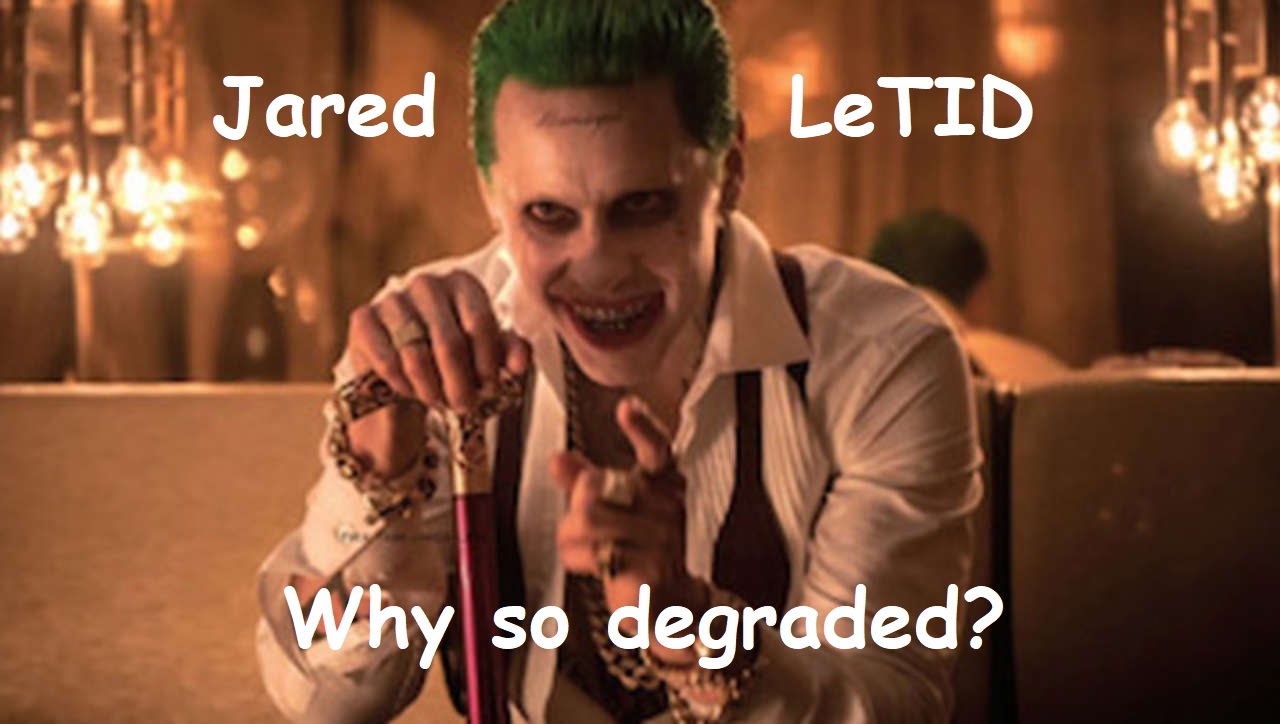

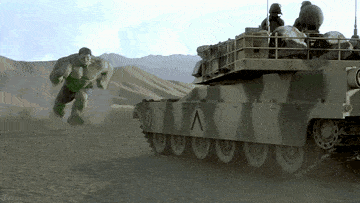
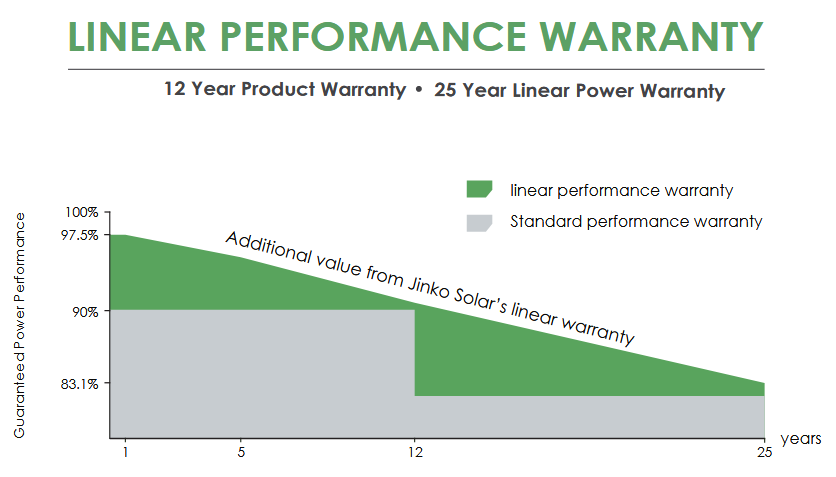

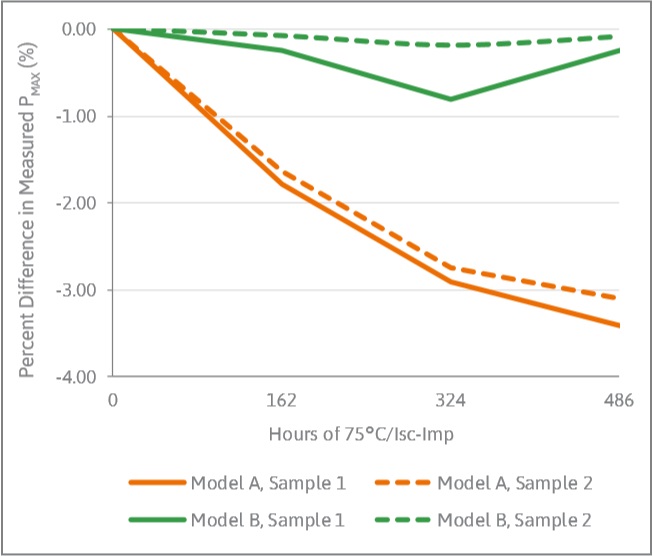

 RSS - Posts
RSS - Posts



Dear Ronald, what do you think of Solar world bisun 280 panels which are manufactured in Germany? which is better? Solar world or Sun power. Also which inverter would you recommend, Fronius or SMA?
Solarworld has declared bankruptcy and since their wattage is relatively low I would guess Solarworld Bisun 280 watt panels haven’t been manufactured for quite a while now.
Despite having financial difficulties, SunPower is still in operation and I would say their panels are likely to be more durable. Fronius and SMA are both good quality inverters so it mostly comes down to price and personal preference. The Fronius warranty is a little better but note they make more noise.
You dont mention QCells who discovered LeTid and mitigated it completely with P Type Silicon.
Good point. Getting Q CELL panels is excellent way to avoid LeTID.
I love your articles for the content, but especially for the easter eggs.
Dont Panic reference I expected to take a Douglas Adams/Arthur Dent spin, but got good old Dad’s Army. Touche
re “But in a hot climate like Brisbane”
As an aside. So is it high average heat that matters more rather than high maximums?
Brisbane is obviously hotter on average than Melbourne, Adelaide, Perth etc.
But it has significantly lower maximum temperatures than those other temperate cities being in the sub-tropics.
For LeTID to become a problem panel temperature has to reach 50 degrees or more a sufficient number of times. This can easily happen whenever the temperature goes above around 30 degrees. As there are plenty of 30 degree plus days in Brisbane I expect it to occur much faster than in Melbourne. But if you head inland from Brisbane I’d expect it to occur even faster in, say, Cunnamulla due to greater temperature extremes.
My panels are 10 years old. At a guess what type of panels would be installed way back in 2010 and how much would the degradation be approx..
Thanks,
Bev
Hi Bev
I’m afraid it is very difficult to say what brand of panels they are likely to be because, like today, there a wide range of different panels were installed. I don’t recommend going up on the roof to check, but if someone does go up on the roof they can use a mobile phone to photograph the label on the back of the panels.
If they were decent quality panels then they should have degraded by under 10%. Unfortunately, many panels that aren’t good quality have been installed. If you know how many kilowatts of panels you have you can use this page to get an idea of how well they compare to a new system:
https://solcast.com/rooftop-solar/free-pv-system-performance-estimation-tool/
You will need to know how many kilowatt-hours a day your system produces for this to be useful.
If you just want to check very quickly if your system is working acceptably you can look at your electricity bills to see if you are still being paid a solar feed-in tariff for a reasonable number of kilowatt-hours. This is very imprecise as electricity consumption can change and you should only compare bills from similar seasons, but at least you can see if there appears to be a major problem.